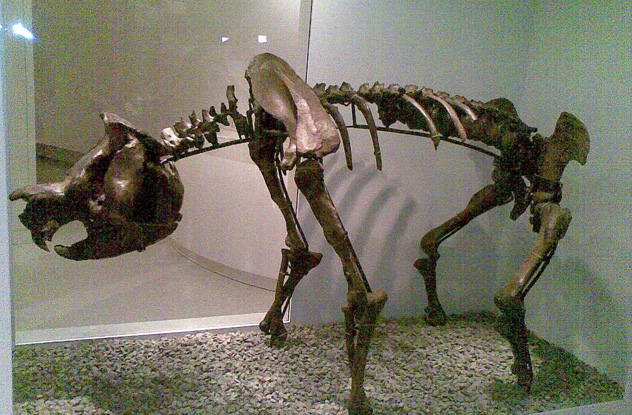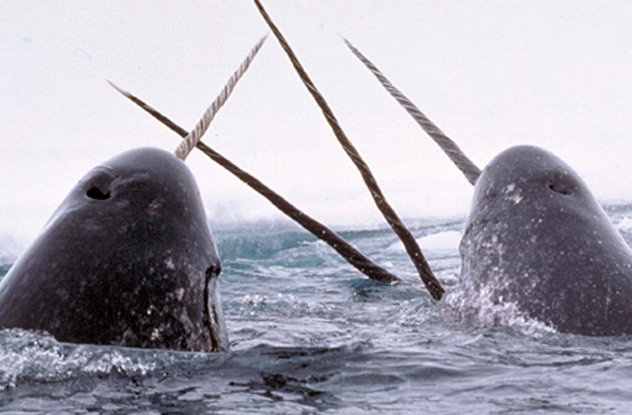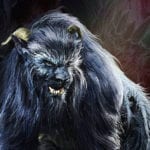 Creepy
Creepy  Creepy
Creepy  Technology
Technology 10 Scientific Breakthroughs of 2025 That’ll Change Everything
 Our World
Our World 10 Ways Icelandic Culture Makes Other Countries Look Boring
 Misconceptions
Misconceptions 10 Common Misconceptions About the Victorian Era
 Mysteries
Mysteries 10 Strange Unexplained Mysteries of 2025
 Miscellaneous
Miscellaneous 10 of History’s Most Bell-Ringing Finishing Moves
 History
History 10 Great Escapes That Ended Right Back in Captivity
 Weird Stuff
Weird Stuff 10 Fascinating Things You Might Not Know About Spiders
 Food
Food 10 Everyday Foods You Didn’t Know Were Invented by the U.S. Military
 History
History 10 Odd Things Colonial Americans Kept at Home
 Creepy
Creepy 10 More Representations of Death from Myth, Legend, and Folktale
 Technology
Technology 10 Scientific Breakthroughs of 2025 That’ll Change Everything
 Our World
Our World 10 Ways Icelandic Culture Makes Other Countries Look Boring
Who's Behind Listverse?

Jamie Frater
Head Editor
Jamie founded Listverse due to an insatiable desire to share fascinating, obscure, and bizarre facts. He has been a guest speaker on numerous national radio and television stations and is a five time published author.
More About Us Misconceptions
Misconceptions 10 Common Misconceptions About the Victorian Era
 Mysteries
Mysteries 10 Strange Unexplained Mysteries of 2025
 Miscellaneous
Miscellaneous 10 of History’s Most Bell-Ringing Finishing Moves
 History
History 10 Great Escapes That Ended Right Back in Captivity
 Weird Stuff
Weird Stuff 10 Fascinating Things You Might Not Know About Spiders
 Food
Food 10 Everyday Foods You Didn’t Know Were Invented by the U.S. Military
 History
History 10 Odd Things Colonial Americans Kept at Home
10 Real-Life Explanations For Famous Myths And Cryptids
Humanity is awash with amazing myths, and some of these simply must have some basis in fact. The following are by no means meant to be definitive and exclusive explanations, and undoubtedly some cases might just be the result of the extraordinary qualities of the human imagination. (And, y’know, Occam’s razor—the simplest solution is sometimes just “that’s made up.”) Skepticism is good and all, and we’ll admittedly have to stretch a bit, but speculation is fun.
10Chupacabras
Sick Dogs And B Movies

Most people’s think of the chupacabra as a dog-like creature. It was in this guise that the chupacabras were defeated by Erik Estrada at the Battle of the Alamo. This type, as we’ve covered before in the specific case of the Cuero chupacabra, is generally found to be canines suffering from mange.
Mange is a nasty disease that consists of mites burrowing under the skin, causing inflammation that blocks blood supply to the hair follicles, resulting in the loss of hair and sometimes secondary skin infections. Blood constriction also leaves the unfortunate creatures with fatigue and general exhaustion such that they often struggle to survive. The remains of alleged chupacabra specimens, when subjected to DNA testing, are invariably revealed them to be sickly dogs, coyotes, and raccoons. Their alleged prey, despite the chupacabra’s vampiric tendencies, are also found to contain plenty of blood when professionally autopsied.
The original chupacabra, first reported in Puerto Rico in 1995, was very different. It was bipedal with a spiked back and had little resemblance to the later canine interpretation. What it did resemble, however, was alien-human hybrid creature Sil from the B movie Species (starring Michael Madsen, Forest Whitaker, Alfred Molina, and Ben Kingsley). That film was released in 1995, and the original witness, Madelyne Tolentino, had seen that film a few weeks prior to her alleged sighting of the chupacabra. In interviews, she even said the movie monster bore a remarkable resemblance to her chupacabra sighting, so either the makers of Species accidentally replicated an undiscovered creature, or their film provided the basis for the Tolentino’s report. There was also an escaped batch of rhesus monkeys with a penchant for walking on their hind legs on the loose in Puerto Rico in 1995, and these could have contributed to further sightings.
9Phantom Cats
Military Mascots And Released Pets

Phantom cats are, put simply, large felines reported in places that they shouldn’t exist (which is indicated by their alternative name—Alien Big Cats). In Britain, this began with a series of sightings throughout the ’70s, with the particularly ferocious Beast of Exmoor allegedly responsible for killing 100 sheep in 1983. That massacre resulted in a £1,600 bounty and even the dispatch of a squad of Royal Marine snipers, but these came to nothing.
While many sightings can be explained as abnormally large or exaggerated house or feral cats, some seem to defy this categorization. For these, it is thought that after the 1976 Dangerous Wild Animals Act prohibited the keeping of dangerous animals, many private collectors made the spectacularly irresponsible decision to release their animals into the wild. This is supported by how smaller foreign cats such as lynxes and an ocelot as well as a tame puma have been captured or killed in Britain. However, the limited lifespan of such cats makes more recent reports less explicable—though the released animals may have bred with locals.
In Australia, meanwhile, there have been numerous reports of panthers or pumas, particularly in outback Victoria and New South Wales. A more ambitious theory suggests the marsupial lion, which is generally thought to have gone extinct along with the rest of Australia’s megafauna some 40,000 years ago. More plausibly, it has been suggested that US servicemen smuggled in pumas to serve as mascots when they served on Australian bases in World War II. From here, they escaped or were released and bred.
Regardless of their origin, the Australian big cats are on the cusp of moving from cryptozoological myth to recognized fact. A 2001 Freedom of Information request showed the NSW government had serious concerns, and a later report conceded that “it seems more likely than not . . . that such animals do exist in NSW.”
8Jason’s Golden Fleece
Alluvial Mining

Jason of Greek mythology is the rightful king of Iolcus, who is sent on an impossible mission to retrieve a golden fleece by his usurping uncle Pelias. So he fits out his ship, the Argo, and sails to retrieve the fleece from Colchis, located at the eastern edge of the Black Sea in modern-day Georgia. Jason then teams up with and marries the daughter of Colchis’s king to make off with the fleece. When they get back to Greece, Jason tries to set aside his wife, and she goes murderously crazy.
We’ve spoken before about the golden takin and how its fur may have inspired the fleece. But this creature lives in the Himalayas, and there is a far simpler explanation arising out of Georgia itself. The locals are said to have used sluice boxes lined with sheepskins to catch alluvial gold. Following this, the coarse gold was shaken out, but the finer gold got stuck in the wet wool, so the sheepskin was hung out to dry before the fine gold was beaten out. Thus, we have a (temporary) golden fleece, which could have been exaggerated or mistranslated into a literal Golden Fleece in oral retelling of legends.
Detractors point out that definitive evidence of this practice dates to the sixth century BC at the earliest, and the story of Jason predates that by at least a few hundred years (it was first written down in Homer’s time, c. 800 BC). Countering this, the definitive version of Jason’s exploits, Apollonius’s of Rhodes Argonautica, was not compiled until the third century BC. Furthermore, Jason’s adventure was not specifically associated with Colchis until c. 700 BC. These later composers may have drawn inspiration from contemporary Colchin practice and not what was happening in the region historically at the time of Jason’s alleged existence (prior to the Trojan War, c. 1300 BC).
7Excalibur, The Lady In The Lake
Celtic Ritual And Steppe Sword Worship

The historicity and possible identity of the legendary King Arthur could probably take up a list of its own, so here we will only deal with the two stories regarding his swords. First, there is the momentous event wherein Arthur proved himself by pulling forth a sword that was embedded in stone. This seems to have vague antecedents on the Steppe, where the Scythians, Sarmatians, and Alans were known to worship a sword implanted in the earth, and inserting the sword into the ground was a symbol of sovereignty.
Furthermore, Alanic and Sarmatian chiefs were chosen from among the best warriors, who presumably played a central role in rituals surrounding the divine sword. Steppe influence on the Arthurian legend is further supported by how Marcus Aurelius exiled 5,500 defeated Sarmatians to Britain in the second century. One of their leaders was even called Lucius Artorius Castus, though the earliness of his life means it’s unlikely he was the historical Arthur. This idea was depicted very loosely in 2004’s King Arthur, which transposed the Sarmatians to the fifth century and had assorted other inaccuracies. Failing this, the tradition could have been picked up from the Alans who moved as far west as Brittany in the Great Migrations during and after the fall of the Roman Empire.
As he died, Arthur commanded that his mighty sword Excalibur be returned to the Lady in the Lake whence he had received it (in some traditions). This seems to straightforwardly reference ancient Celtic practice wherein swords and other valuable items were deposited in lakes as offerings to the gods—the Romans reportedly recovered 50 tons from such a deposit near Toulouse. Water was apparently revered as a source of healing (which is reflected elsewhere in Arthurian legend) but also as a dwelling place for spirits and potential portal between the physical and spiritual worlds. Furthermore, there is some evidence this practice continued into the (very Christian) Middle Ages, in which case the story may reflect contemporary custom as of the 15th century when Le Morte d’Arthur was composed by Thomas Malory.
6Vampires
Rabies, Tuberculosis And Porphyria

Several diseases have been put forth to explain vampire myths. Porphyria can cause sensitivity to sunlight, be exacerbated by garlic, and make the teeth and gums taut (thereby accentuating the teeth). The claim that porphyria sufferers instinctively crave blood, however, is untrue.
Rabies is another popular option, mainly because it is spread by biting, and rabid humans have been known to bite. Dr. Juan Gomez-Alonso built on this, claiming that the aversion to garlic and light could be caused by hypersensitivity, a symptom of the disease. Their nocturnal habits can also be attributed to the effect rabies has on the sleep cycle. Furthermore, the animals most often associated with vampires—wolves and bats—are also susceptible to the disease and often infect humans.
The vampire scares in 19th-century New England, meanwhile, can be explained by tuberculosis. Often before dying of this, someone would infect their family members, and when those family members only began exhibiting symptoms after their loved ones’ deaths, people sought a supernatural explanation. They came to the conclusion that the dead were preying on their family from beyond the grave and literally sucking out their life force. Thus they began exhuming and burning corpses. Elsewhere, suspected vampires were staked, decapitated, or weighed down with bricks before they were reburied. A poor understanding of decomposition likely contributed to these beliefs, with fluids of decay misinterpreted as fresh blood.
5Yetis
Bears

In 2013, Oxford geneticist Brian Sykes posited a solution to the yeti mystery based on his DNA analysis of two hair samples. His claimed that the samples matched the DNA from the jawbone of an ancient polar bear from 40,000–120,000 years ago, suggesting that the yeti was inspired by a previously unknown polar bear–brown bear hybrid descended from the ancient polar bear. His methodology came into question, and most now believe his samples were the damaged DNA of a modern Alaskan polar bear or that of a brown bear, which exists in the region. The extreme genetic closeness of the two species makes them easy to mistake.
Nevertheless, the yeti could be based on the species of bear that do exist in the region, namely the Tibetan blue bear, Asiatic black bear, and the aforementioned Himalayan brown bear. In addition to the kerfuffle mentioned above, purported yeti samples have regularly been matched to these animals. A series of supposed yeti skins collected by famed explorer Edmund Hillary turned out to be brown bear pelts, and a rather exhaustive Chinese investigation came to the same conclusion.
So did mountaineer Reinold Messner. In a series of expeditions, the locals regularly took him to yeti lairs that were bear dens, presented a stuffed yeti that turned out to be a Tibetan brown bear, and during encounters with brown or blue bears regularly insisted the creature was a yeti. Consequently, he has come to the conclusion that the yeti is a combination of several bear species spiced up so they can provide moral tales about the dangers of the wild to young would-be Sherpas. Furthermore, the yeti of the Western imagination was built up into something more monstrous, sensational, far-fetched, and ape-like by early Western explorers, with problems of mistranslation also playing a role.
These various bear species even have several traits comparable to the yeti. The blue bear regularly walks on its hind legs. The black bear, when about two years old, spends much of its time in trees to avoid predation by adult bears, and during this period, they train their inner claw inward for assistance in climbing. This can give its tracks the appearance of a bipedal hominid with an inward-stretching thumb or big toe. Such an explanation for the yeti is far simpler than that offered by some Bigfoot enthusiasts, who claim that the yeti, Sasquatch, and other ape-like cryptids can be explained as surviving populations of Gigantopithecus, which is thought to have gone extinct 300,000 years ago. How a 3-meter (10 ft), 500-kilogram (1,200 lb) creature could be secretive enough to be unknown to science and how the South Asian Gigantopithecus became the North American Sasquatch seem like pertinent questions here.
4Area 51
UFOs And Spy Planes

Area 51 is the holy grail of conspiracy theorists, renowned as a top-secret base where the nefarious United States government experiments with alien technology, including UFOs. It also actually exists, as detailed by CIA documents released by a Freedom of Information Act request in 2013. Though they didn’t admit to diddling about with alien tech, this did reveal a potential source of UFO rumors—the base was home to the development and pilot training of two spy planes, beginning in 1955.
The first of these, the U2, flew at 20,000 meters (60,000 ft) at a time when commercial flights didn’t exceed 6,000 meters (20,000 ft) and warplanes (such as the B-47) didn’t exceed 12,000 meters (40,000 ft). Furthermore, the sunlight glinting off the U2’s silver wings appeared to be fairy lights, which are often associated with UFO sightings.
Successor A-12, codenamed OXCART, is perhaps even more intriguing. This remarkable vehicle traveled 3,000 kilometers (2,000 mi) per hour while taking pictures that could identify foot-long objects on the ground from an altitude of 27,000 meters (90,000 ft). It underwent almost 3,000 top secret test flights before being publicly revealed in the mid-’60s. The A-12 never saw active service over the USSR, having been immediately superseded by the SR-71 Blackbird. Nevertheless, an oddly shaped vehicle, unidentifiable to commercial air controllers or pilots, with sunlight brightly glaring off its titanium wings, could doubtless explain many UFO sightings. Indeed, the CIA document suggests as many as half of reported sightings in the late ’50s and early ’60s were the result of U2 or A-12 flights.
Other incidents could contribute to the UFO legends. For example, a 1963 A-12 crash was rapidly covered up, with all debris removed and the incident passed off as an accident involving a cookie-cutter F-105. The pilot, Kenneth Collins, ejected and was picked up by three guys in a truck. To dissuade their inquisitive instincts, he told them there was a nuclear weapon onboard, and they were later made to sign national security nondisclosures. Collins himself alleges he received a truth serum in his debriefing. While that might seem to stretch credibility, the CIA was conducting controversial experiments through MK-ULTRA, and later on, US military intelligence had people trying to kill goats by staring at them, so his story seems rather believable.
So, the US government did cover up crashes, and there were secretive, advanced machines flying about around Area 51, but no aliens were involved.
3Bunyips
Megafauna

Reports of the bunyip in the Australian outback vary wildly. It has been said to have fur or feathers, legs or flippers, and vary in size from that of a small dog to an elephant. Various European accounts compare the creature to hippopotami, horses, alligators, walruses, canines, and kangaroos. Nevertheless, it is usually large, mammalian, and associated with water.
Prehistoric Australia had many creatures that fit these characteristics in the form of its unique marsupial megafauna. This bizarre menagerie included giant kangaroos, goannas, koalas, and echidnas as well as a marsupial lion, the horse-sized Palorchestes equipped with claws for stripping bark, and the rhino-sized Diprodont, a relative of the wombat. An especially interesting species, given the bunyip’s association with water, is the Zygomaturus trilobus. Specimens of this have largely been found in areas of former swampland, leading to suggestions it was a semi-aquatic marsupial hippopotamus.
These animals largely went extinct 40,000–50 000 years ago, and many therefore coexisted (for a while) with Aboriginal groups, whose ancestors arrived approximately 50,000 years ago. Human arrival seemingly coinciding with the megafauna extinction has led to a prolonged debate about whether the extinction was human-driven, but this has become increasingly marginalized in favor of climate explanations. This coterminous existence may have been enough for the megafauna to imbue themselves in Aboriginal mythology, especially with select species that may have endured around 20,000 years ago.
2Unicorns
Rhinos And Narwhals

The Elasmotherium was a relative of the woolly rhinoceros, which ranged the Russian steppe during the ice ages. It was up to 6 meters (20 ft) long and weighed up to 4 tons but, unlike its cousin, the Elasmotherium, had only a single horn. Fossil evidence is spotty and can only be dated to 50,000 years ago, but some have it surviving until the end of the last ice age some 10,000–11 000 years ago. Furthermore, the oral traditions of the Evenks people of Siberia as well as occasional Chinese and Persian sources suggest it may have survived in pockets for even longer. This certainly isn’t inconceivable, as dwarf woolly mammoths are known to have survived to within 4,000 years ago on Russia’s Wrangel Island.
While it didn’t come into contact with European populations, if the later estimates of extinction are correct, the Elasmotherium may have coexisted with humans in the eastern end of its range for some 25,000 years. It is postulated that a strong oral tradition led memories of the creature to be passed down from generation to generation and eventually become the mythical Chinese unicorn known as zhi.
In Europe, meanwhile, unicorns arose from the eighth-century Greek Ctesias’s book on India, in which he managed to conflate a wild donkey, a tamed Asian rhino, and (possibly) a Tibetan antelope. He ascribed the creature numerous magical and medicinal qualities, which encouraged the trade of African rhino horns in Europe. The final touch was completed by Roman naturalist Aelian, who changed the nature of the horn from smooth (like a rhino) to a spiral. As a result, narwhal tusks were eventually confused with unicorn horns and became prized—Queen Elizabeth paid £10,000 for one in the 16th century, and the Danish coronation throne constructed in the 17th was composed of narwhal tusks. The unicorn/narwhal throne hasn’t been used since 1840, when the change from absolute to constitutional rule meant monarchs no longer received coronations.
1Dragons And Griffins
Dinosaurs

Belief in dragons is one of the most widespread myths, having evolved independently in China, Europe, Australia, and the Americas. A leading theory posits that stories of dragons arose from primitive people misinterpreting dinosaur fossils. The fourth-century Chinese historian Chang Qu wrote about the discovery of a dragon two millennia ago, illustrating the mystery such a discovery would have for ancient people. Some recent discoveries have added weight to this theory. The 66-million-year-old Dracorex, with its long muzzle and spiked visage, strongly resembles dragons and is named as such. Stanford scholar Adrienne Mayor, who has done extensive research in this area, suggested the Dracorex could have inspired the dragon-like unktehi of Sioux mythology (the specimen was discovered in Dakota).
Meanwhile, the extremely long-necked Qijianlong has been associated with Chinese dragon myths. It has been speculated that people may have come across the neck vertebrae embedded in the earth and then extrapolated its appearance from their knowledge of crocodiles. Indeed, it is known that the Chinese misattributed dinosaur bones to dragons—for at least two and a half millennia, they’ve been grinding up fossils for medicinal use in dragon tonics.
In the Gobi Desert of neighboring Mongolia, meanwhile, well-preserved fossils of the Protoceratops may have helped inspire griffins. This hornless relative of the Triceratops had a beak (hence the griffin’s bird-head) and a quadrupedal body, while the thin frill could break easily and come to resemble a griffin’s ears, and its elongated shoulder blades could be misinterpreted as wings.
Tyler hopes to lose his tenuous grip on reality in the hopes that insanity will bring him happiness. You can abuse him via email or Facebook.








